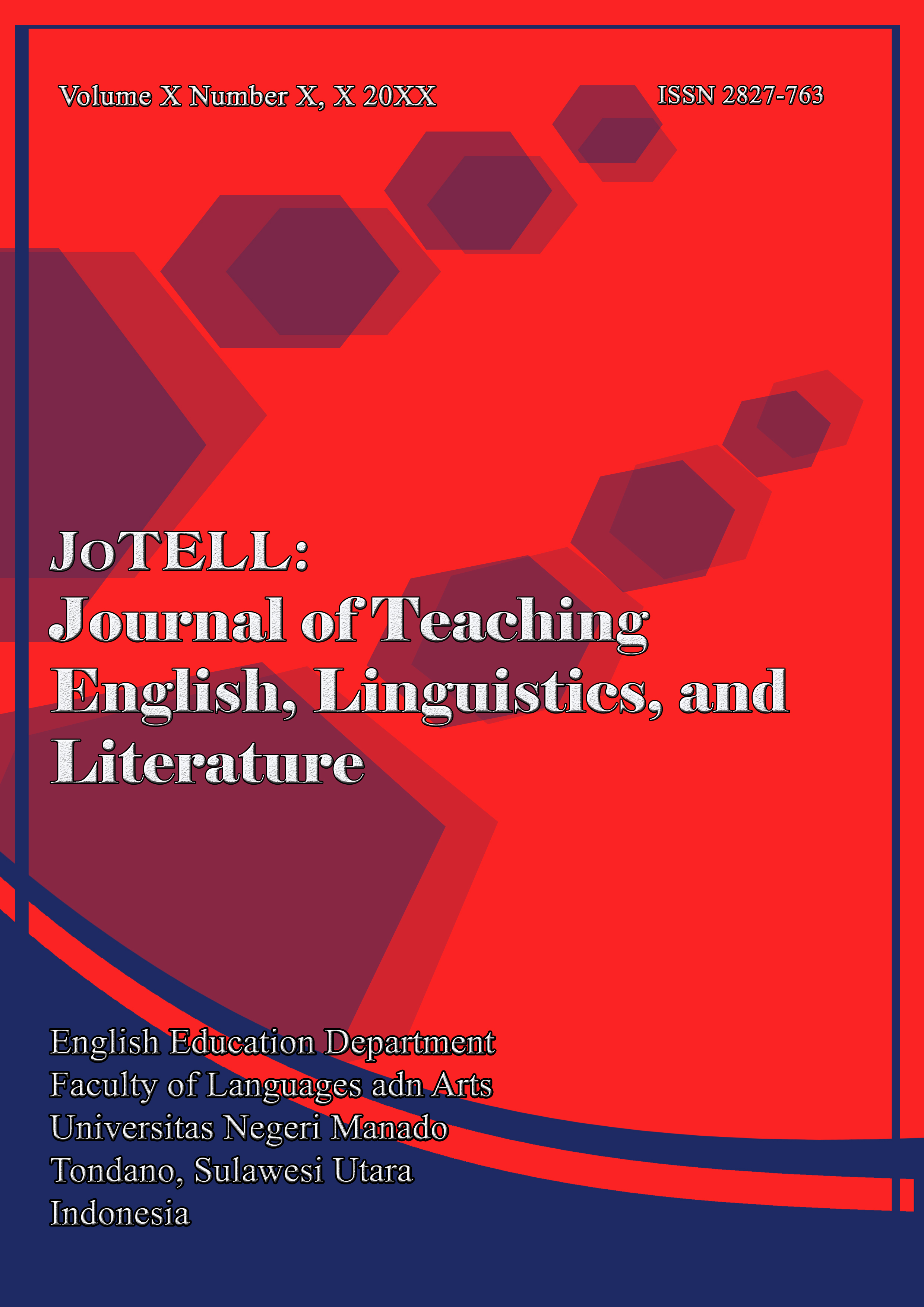ANXIETY DISORDER AS REFLECTED IN JAY AHSER’S THIRTEEN REASONS WHY MAIN CHARACTER
DOI:
https://doi.org/10.36582/jotell.v2i12.7984Keywords:
Anxiety disorder, psychoanalysis, personalityAbstract
The purpose of this study is to find out the kinds of anxiety and its causes experienced by the main character Hannah Baker in the novel Thirteen Reasons Why. He was badly treated by his friends, teachers and parents. All bad things happened to Hannah then bring anxiety in Hannah Baker's life. The method used of this research is qualitative with psychological approach by Sigmund Freud. The data that are taken from the monologue and dialogue with the other characters in the novel. The study using the psychological approach of Sigmund Freud. The primary source is the 2007 book Thirteen Reasons Why by Jay Asher, while secondary sources include various related publications and online resources that provide credence to the subject. The result of the study showed there are three kinds of anxiety. The first is neurotic anxiety, when Hannah scares to share her phone number with her friend. The next is realistic anxiety, when a Hannah’s friend is staring at her in the house and scares her. The last is moral anxiety that is when she doesn't join the funeral of a driver who makes herself scared by what others think about her. The author also found causes of such anxiety: environment, frustration, threat, gender and fear. From all the data found in the novel, it proves that Hannah Baker suffered anxiety and eventually died of suicide.
References
Aji, H. A. P. (2019). Struktur peranti mental (id, ego, super ego) pesantren dalam intimasi dengan lawan jenis. Jurnal Psikologi: Jurnal Ilmiah Fakultas Psikologi Universitas Yudharta Pasuruan, 6(2), 114-127.
Aras, G. (2015). Personality and individual differences: Litarature in psychology-psychology in literature. Procedia-social and Behavioral Sciences, 185, 250-257.
Asher, J. (2007). 13 Reasons Why. New York: RazonBill.
Asyifa, U. N., & Suharyati, H. (2019). The Main Characters Anxiety Disorder in the Novel Blue Skies by Catherine Anderson. Journal Albion: Journal of English Literature, Language, and Culture, 1(1).
Bogdan, Robert C. dan Biklen Kopp Sari, 1982, Qualitative Research for Education: An Introduction to Theory and Methods. Allyn and Bacon, Inc.: Boston London.
Cole, A.H. (2014). Anxiety. In: Leeming, D.A. (eds) Encyclopedia of Psychology and Religion. Springer, Boston, MA.
DiYanni, R. (200). Literature: Reading Fiction, Poetry and Drama. United States: The McGraw-Hill Companies Inc.
Farkhatun, A. (2017). Anxiety and Defense Mechanism of Rachel Watson in Paula Hawkins’novel The Girl on The Train (Doctoral dissertation, UIN SUNAN KALIJAGA YOGYAKARTA).
Freud, S. (2006). A general introduction to psychoanalysis. New York: Washington Square. Press, Inc.
Freud, S. (1923). The Ego and the Id. The Standard Edition of the Complete Psychological Works of Sigmund Freud, Volume XIX (1923-1925): The Ego and the Id and Other Works, 1-66
Freud, S. (1959/1989). Inhibitions, symptoms, and anxiety (J. Strachey Ed., trans: Strachey, A.) (Rev. ed.). New York: W. W. Norton.
Freud, S. (1989). The ego and the id (1923). TACD Journal, 17(1), 5-22.
Griffith, K. (1986). Writing Essays About Litaerature. Washington Hartcourt Brace Jovanonic Inc.
Griffith, K. (2011). Writing Essays About Literature: Guide and Style Sheet, Eight Edition. Cengane Learning.
Inaya, M. K. (2021). The Anxiety of Pauline and Madeline in Nicola Yoon's Everything, Everything (Doctoral dissertation, Universitas Islam Negeri Maulana Malik Ibrahim).
Kessler, R. C., Ruscio, A. M., Shear, K., & Wittchen, H. U. (2010). Epidemiology of anxiety disorders. Behavioral neurobiology of anxiety and its treatment, 21-35.
Klein, F. D. (2002). Historical aspects of anxiety. Retrieved from https://www.ncbi.nlm.nih.gov/pmc/articles/PMC3181682/
Lapsley, D. K., & Stey, P. C. (2011). Id, ego, and superego. Encyclopedia of human behavior, 2.
McLean, C. P., Asnaani, A., Litz, B. T., & Hofmann, S. G. (2011). Gender differences in anxiety disorders: prevalence, course of illness, comorbidity and burden of illness. Journal of psychiatric research, 45(8), 1027-1035.
Mogea, T., & Joshua, S. R. (2022). DIGNITY AS SEEN IN TENNESSEE WILLIAMS’A STREETCAR NAMED DESIRE. Jurnal Pendidikan dan Sastra Inggris, 2(3), 85-96.
Mogea, T. (2023). Character of Ralph as Seen in William Golding's Lord of the Flies. Journal of Creative Student Research, 1(2), 171-188.
Organization, W. H. (2022). Mental Disorder. Retrieved from https://www.who.int/neews-room/fact-sheets/detail/mental-disorders
Pradopo, R. D., Abdullah, I. T., Supriyadi, S., & Sugihastuti, S. (1994). Wajah Indonesia dalam sastra Indonesia: puisi 1960-1980.
Wang, J. (2020). An Analysis of Salieri in Amadeus from Freudian Personality Theory: Id, Ego, Superego. In 3rd International Conference on Interdisciplinary Social Sciences & Humanities (SOSHU 2020). https://doi. org/10.25236/soshu.
Downloads
Published
How to Cite
Issue
Section
License
Copyright (c) 2023 JoTELL : Journal of Teaching English, Linguistics, and Literature

This work is licensed under a Creative Commons Attribution-ShareAlike 4.0 International License.












